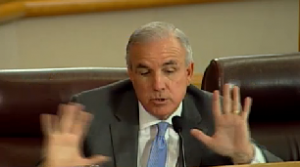Miami-Dade County, accused of wrongly allocating $13 million in federal grants that must be repaid to the U.S. Housing and Urban Development Department, is about to dole out another $12.5 million of the very same Community Development Block Grants (CDBG), Home Investment Partnerships (HOME) and State Housing Initiatives Partnership (SHIP) monies.
of the very same Community Development Block Grants (CDBG), Home Investment Partnerships (HOME) and State Housing Initiatives Partnership (SHIP) monies.
How do we know we won’t have to pay those back next year?
Mayor Carlos “Mr. Giveaway” Gimenez recommended the grants to the commissioners last month, and they gave it preliminary approval. But maybe they should take another look at the process before rubber stamping his list.
It’s not like the county hasn’t thrown money away before.
HUD has decreed that the county must repay $13 million in the exact same CDBG and HOME funds because these were “used on activities that U.S. HUD has deemed ineligible,” according to a memo from Gimenez to the commission.
True to his form, Gimenez — the same mayor who traded a $32 million debt to Miami Beach for an $800 million extension of their CRA so he could defer payments for two years — has suggested that the county pay back the monies through decreased grant allocations for the next three years. Instead of taking it out of the general fund all at once, he wants to pay with installments of basically future HUD monies.
That might be smart, actually, if we don’t need those funds in the next three years and if he can pull it off. Because in his memo, Gimenez admits there is no guarantee that HUD is going to accept the payment plan and the mayor may have to come back to the commission with his tail between his legs and say, “Ooops, I need to pay the $13 million now.”
Read related story: Miami-Dade: Carlos Gimenez saves us — from himself
But this seems to be a broken record with Miami-Dade and HUD: In 2011, the county had to pay back HUD back $3.6 million back because of shoddy accounting practices.
That’s why maybe we should think twice before doling out this new batch of grants for $12.5 million. Have we changed the process of verifying eligibility? Have we made sure we comply with the U.S. HUD criteria? Especially since HUD recently announced new rules that will make sure that cities and county governments adhere to the requirements.
These funds “are designed to support projects that generate economic development opportunities within underserved communities,” a statement from the county says. “The projects are integrated in long range community strategies and leverage public-private partnerships to revitalize areas of Miami-Dade County. The approved funding can be used to build community facilities, roads, and parks, to repair or rehabilitate housing, to provide new or increased public services to local residents or to fund initiatives that generate or retain jobs.”
Gimenez said, in the statement that he was glad the commissioners  approved funding that “will result in redevelopment in low-to moderate-income communities.”
approved funding that “will result in redevelopment in low-to moderate-income communities.”
Didn’t he say the same thing, though, about the $13 million that previously went to two organizations that did not meet the criteria?
Of this year’s $12.5 million, the largest check is going to the St. John Community Development Corporation, which gets $636,364. But the two next biggest checks, for the largest total amount, are going to one address: Neighbors and Neighbors Association and the Black Economic Development Coalition, both of which share an address and two principals, get $612,773 a piece. That’s $1.2 million to basically one office.
Camillus House is next with $576,597, followed by the Opa-Locka Community Development Corporation, with $520,180, the Sundari Foundation Inc. d/b/a/ Lotus House Women’s Shelter, which gets $458,839, the Ecotech Visions Foundation, with $450,000 and Partners for Self-Employment, which gets $430,000.
Funds are provided for categories including, but not limited to, technical
There’s more. Please press this “continue reading” button to “turn the page.”
Pages: 1 2

